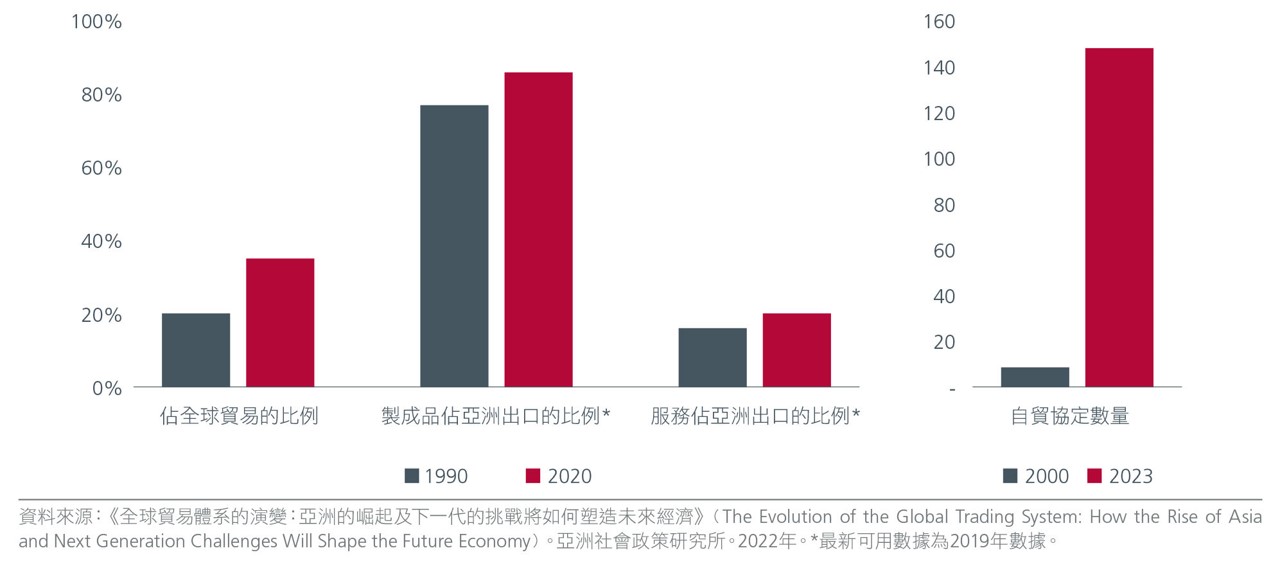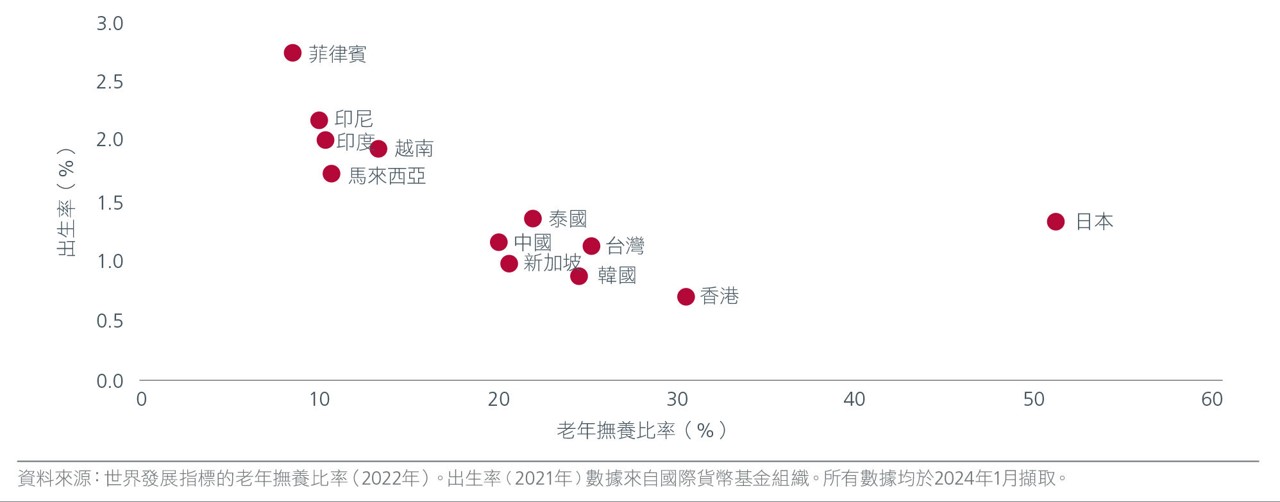摘要
- 過去 30 年,亞洲的經濟成長模式不斷演變,亞洲也持續實現內部轉型。亞洲歷來一直迅速成長,預計到 2030 年,亞洲仍將貢獻全球經濟成長的 60%。
- 亞洲在多個行業產生了顛覆行業的公司,為投資人提供更多參與亞洲成長的途徑。
- 隨著推動改變的因素加速發展,加上地緣政治變得日益複雜,投資人將需要經驗、靈活性及深入的本地洞察,以投資充滿活力的亞洲。
作為瀚亞 30 週年里程碑的一部分,我們策劃了一系列文章,探討亞洲在過去三十年的轉型,並分享我們投資團隊多年來投資亞洲所獲得的見解。這些文章旨在幫助投資者更深入了解亞洲的經濟成長潛力及投資機會。我們這個系列的首篇文章探討了亞洲不斷變化的經濟成長模式如何影響投資者。
過去三十年,亞洲經濟快速成長,名義國內生產總值在 1990 年至 2022 年間成長了近 16 倍,而全球經濟同期則成長了 9 倍 1。在這段時期,人口結構變化、科技進步及地緣政治發展形勢塑造了亞洲的經濟成長模式。
貿易地位的轉變
亞洲佔全球經濟的比重由 1990 年的 21% 上升至 2023 年的 39%2。貿易歷來是經濟成長的重要動力——亞洲是全球最大的貿易地區,佔全球貿易的比例由 1990 年的約 20% 上升至2020 年的 35%3。亞洲的自由貿易協定(自貿協定)數量不斷增加,反映了貿易發揮著重要作用。2000 年,亞太區僅簽署了 8 項自貿協定。2023 年,亞太區已簽署 147 項自貿協定,另有 87 項正在商議中4 。
儘管貿易仍然重要,但其結構卻發生了顯著變化。隨著初級產品出口下降,製成品佔亞洲出口的比例由 1990 年的 77% 上升至 2019 年的 86%5。話雖如此,該「世界工廠」越來越少依賴廉價勞工來維持其競爭優勢。亞洲透過採用先進科技及積極創新來提升價值鏈,並使工業基礎更多元化。因此,亞洲今天匯聚了世界級的機械及工業產品製造商、領先的半導體晶片製造商、封裝商及集成電路設計公司。多間公司也將長期建立的製造優勢與新科技相結合,成為全球可再生能源及電動車供應鏈的主要供應商,從而為投資者創造多元化的投資機會。
數碼科技也促成了新的跨境交易及電子商貿模式。2022 年,亞洲佔全球電子商貿銷售的 51%6,幾乎是 2014 年的兩倍。這種成長導致更多亞洲平台及電子商貿公司在近年冒起。
圖1、亞洲貿易的演變

鑑於地緣政治不確定性及對國家安全的需求日益增加,多個西方國家越來越積極加強其國內工業,尤其是在可再生能源及半導體等關鍵領域。這將對亞洲未來的貿易產生重要影響。由於美國的貿易限制不斷增加,中國正在推動出口目的地多元化,並增加在東盟及拉丁美洲的市場佔有率。
消費者紅利
雖然貿易對亞洲仍然重要,但由於亞洲中產階級迅速壯大,國內消費成為日益重要的成長動力,尤其是對印度及東南亞經濟體而言。人口結構在這方面發揮著重要作用。根據經濟合作暨發展組織(OECD)的數據,假設沒有淨移民且死亡率不變,每名婦女生育 2.1 個孩子的總生育率能確保人口大致維持穩定。按此指標衡量,菲律賓、印度、印尼及越南表現良好。這些國家的老年撫養比率也是亞洲最低之列7 ,對勞動人口的壓力較小,並可能令資源分配更加均衡。圖2。
圖2、東盟及印度的人口結構理想

印度在 2023 年成為全球人口最多的國家,目前預計將在 2027 年成為全球第三大消費市場。與此同時,東盟的人口達 6.618 億,是全球人口第三大的地區。穩健的消費提高了東盟經濟體在出口低迷時期的韌性。其龐大的國內消費市場也吸引了全球製造商在當地設立生產設施。亞洲的區內貿易比例由 1990 年的 42% 增加至 2019 年的 53% 8。投資及就業機會增加令亞洲受惠,並在非必需消費品、房地產及金融行業創造了投資機會。
新的經濟秩序?
亞洲不同國家的經濟地位多年來也不斷演變。加入世貿組織後,中國佔亞洲經濟的比例迅速增加,佔亞洲國內生產總值的比例由 1990 年的 10% 以下迅速增加至 2022 年的 50% 以上。與此同時,日本佔亞洲國內生產總值的比例由 1990 年的 60% 下降至 13%9。圖3。因此,1995 年的《財富》世界 500 強公司中有 162 間日本公司。2023 年,世界 500 強名單中有 137 間中國公司及 41 間日本公司。話雖如此,這兩個經濟體的經濟形勢不斷演變。房地產行業低迷及消費者信心疲弱使中國近期經濟前景蒙上陰霾10。另一方面,受惠於通脹上升及企業改革,日本的經濟前景有所好轉。
圖3、佔亞洲國內生產總值的比例

除了中國及日本之外,其他亞洲經濟體的經濟地位也在不斷演變。超級大國之間的競爭加劇,加上各國有意優先考慮國家安全而非經濟效率,導致全球供應鏈重新平衡,利好印度及東盟。預計印度將在 2024 年成為亞洲第二大經濟成長引擎。11印度的生產掛鈎獎勵計劃幫助該國躍過基礎製造業,並專注於更先進的製造業。與此同時,印尼正在利用其豐富的鎳及鈷儲量來發展綜合電動車供應鏈,目標是到 2027 年成為全球三大電動車電池生產國之一。自 2013 年以來,印度及印尼均取得了重大進展,當時它們位列「脆弱五國」——此新創造的術語用於描述嚴重依賴不穩定的外國投資來推動經濟成長的經濟體。
投資於充滿活力的亞洲
預計到 2030 年,亞洲將貢獻全球經濟成長的 60%12其經濟成長模式將如過去 30 年般繼續演變。亞洲不斷變化的格局也在不同行業產生了顛覆行業的公司,為投資者提供更多參與亞洲成長的途徑。展望未來,由於數碼科技的進步、可持續發展的重要性與日俱增以及地緣政治形勢更複雜,推動亞洲改變的因素預計將加速發展13。投資者較以往更需要經驗、靈活性及深入的本地洞察,以投資充滿活力的亞洲。
密切關注本系列的下一篇文章,文章將重點分享過去 30 年投資亞洲股市的見解。
1. IMF Datamapper。數據於2024年1月5日擷取。國內生產總值,當前價格。亞洲包括中國、香港、印度、印尼、日本、馬來西亞、菲律賓、韓國、新加坡、台灣及越南。
2. 國際貨幣基金組織。數據於2024年1月擷取。
3. 《全球貿易體系的演變:亞洲的崛起及下一代的挑戰將如何塑造未來經濟》(The Evolution of the Global Trading System: How the Rise of Asia and Next Generation Challenges Will Shape the Future Economy)。亞洲社會政策研究所。2022年。
4. 同註3。
5. 同註3。
6. 全球零售電子商貿收入。資料来源:Statista。2024年。
7. 世界發展指標。數據於2024年1月擷取。
8. 世界25大貿易國的演變。https://unctad.org/topic/trade-analysis/chart-10-may-2021
9. 國際貨幣基金組織。名義國內生產總值(當前價格,美元計)。數據於2024年1月擷取。
10. https://www.worldbank.org/en/news/press-release/2023/12/14/sustained-policy-support-and-deeper-structural-reforms-to-revive-china-s-growth-momentum-world-bank-report
11. 2024年亞洲展望︰儘管中國存在風險,亞洲仍將推動全球經濟增長》(Asia outlook 2024: Driving global growth despite risks in China)。經濟學人智庫預測。
12. https://www.weforum.org/agenda/2019/12/asia-economic-growth/
13. https://www.imf.org/en/News/Articles/2021/09/27/sp092721-the-future-of-finance-and-the-global-economy
Singapore and Australia (for wholesale clients only) by Eastspring Investments (Singapore) Limited (UEN: 199407631H), which is incorporated in Singapore, is exempt from the requirement to hold an Australian financial services licence and is licensed and regulated by the Monetary Authority of Singapore under Singapore laws which differ from Australian laws.
Hong Kong by Eastspring Investments (Hong Kong) Limited and has not been reviewed by the Securities and Futures Commission of Hong Kong.
Indonesia by PT Eastspring Investments Indonesia, an investment manager that is licensed, registered and supervised by the Indonesia Financial Services Authority (OJK).
Malaysia by Eastspring Investments Berhad (531241-U).
United States of America (for institutional clients only) by Eastspring Investments (Singapore) Limited (UEN: 199407631H), which is incorporated in Singapore and is registered with the U.S Securities and Exchange Commission as a registered investment adviser.
European Economic Area (for professional clients only) and Switzerland (for qualified investors only) by Eastspring Investments (Luxembourg) S.A., 26, Boulevard Royal, 2449 Luxembourg, Grand-Duchy of Luxembourg, registered with the Registre de Commerce et des Sociétés (Luxembourg), Register No B 173737.
United Kingdom (for professional clients only) by Eastspring Investments (Luxembourg) S.A. - UK Branch, 10 Lower Thames Street, London EC3R 6AF.
Chile (for institutional clients only) by Eastspring Investments (Singapore) Limited (UEN: 199407631H), which is incorporated in Singapore and is licensed and regulated by the Monetary Authority of Singapore under Singapore laws which differ from Chilean laws.
The afore-mentioned entities are hereinafter collectively referred to as Eastspring Investments.
The views and opinions contained herein are those of the author on this page, and may not necessarily represent views expressed or reflected in other Eastspring Investments’ communications. This document is solely for information purposes and does not have any regard to the specific investment objective, financial situation and/or particular needs of any specific persons who may receive this document. This document is not intended as an offer, a solicitation of offer or a recommendation, to deal in shares of securities or any financial instruments. It may not be published, circulated, reproduced or distributed without the prior written consent of Eastspring Investments. Reliance upon information in this posting is at the sole discretion of the reader. Please consult your own professional adviser before investing.
Investment involves risk. Past performance and the predictions, projections, or forecasts on the economy, securities markets or the economic trends of the markets are not necessarily indicative of the future or likely performance of Eastspring Investments or any of the funds managed by Eastspring Investments.
Information herein is believed to be reliable at time of publication. Data from third party sources may have been used in the preparation of this material and Eastspring Investments has not independently verified, validated or audited such data. Where lawfully permitted, Eastspring Investments does not warrant its completeness or accuracy and is not responsible for error of facts or opinion nor shall be liable for damages arising out of any person’s reliance upon this information. Any opinion or estimate contained in this document may subject to change without notice.
Eastspring Investments (excluding JV companies) companies are ultimately wholly-owned/indirect subsidiaries/associate of Prudential plc of the United Kingdom. Eastspring Investments companies (including JV’s) and Prudential plc are not affiliated in any manner with Prudential Financial, Inc., a company whose principal place of business is in the United States of America or with the Prudential Assurance Company, a subsidiary of M&G plc (a company incorporated in the United Kingdom).







